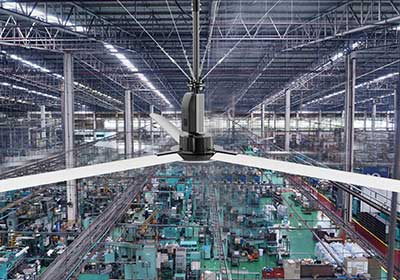
HVLS fans, also known as High Volume Low Speed fans, are specifically engineered industrial fans that efficiently circulate air in large indoor areas such as warehouses, factories, and sports arenas. These fans, notable for their vast size and slow blade speed, facilitate a broad dispersion of air across wide areas. HVLS fans stand out as a cost-friendly and energy-conserving means to augment comfort and air quality in large indoor environments.
HVLS fans operate by leveraging their sizable blades rotating at a gentle pace, typically between 30 and 90 revolutions per minute (rpm). The slowed blade velocity enables the fan to move an impressive volume of air, albeit with less force and noise compared to conventional high-speed fans. The air movement induced by HVLS fans is smooth and steady, offering a comfortable and revitalizing airflow for individuals and animals within the vicinity. These fans are typically ceiling-mounted or suspended from the ceiling using mounting kits. The fan blades are connected to a central hub, which a motor drives. Usually located on a beam above the fan, the motor connects to the hub via a belt or a direct drive system, powered by either electricity or a fuel source such as natural gas.
HVLS fans furnish several advantages for vast indoor spaces. Their energy efficiency is one of their primary benefits. Given their operation at a slower speed and ability to move a larger air volume, HVLS fans consume less energy compared to their traditional high-speed counterparts. This reduced energy consumption allows them to operate for extended durations without significant energy costs. Another perk of HVLS fans is their capacity to enhance indoor air quality. By ensuring a constant air flow within a space, HVLS fans help remove stagnant air and augment overall air quality, which is especially crucial in environments with high levels of dust or other particulates.